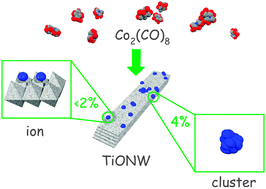Metal loading determines the stabilization pathway for Co2+ in titanate nanowires: ion exchange vs. cluster formation
Abstract
Co

* Corresponding authors
a Department of Applied and Environmental Chemistry, University of Szeged, Hungary
b
Department of Physical Chemistry and Materials Science, University of Szeged, Aradi vértanúk tere 1., H-6720 Szeged, Hungary
E-mail:
jkiss@chem.u-szeged.hu
Fax: +36 62 546482
Tel: +36 62 544803
c MTA-SZTE “Lendület” Porous Nanocomposites Research Group, Hungary
d MTA-SZTE Reaction Kinetics and Surface Chemistry Research Group, Rerrich Béla tér 1., H-6720 Szeged, Hungary
Co

 Please wait while we load your content...
Something went wrong. Try again?
Please wait while we load your content...
Something went wrong. Try again?
D. Madarász, G. Pótári, A. Sápi, B. László, C. Csudai, A. Oszkó, Á. Kukovecz, A. Erdőhelyi, Z. Kónya and J. Kiss, Phys. Chem. Chem. Phys., 2013, 15, 15917 DOI: 10.1039/C3CP51502H
To request permission to reproduce material from this article, please go to the Copyright Clearance Center request page.
If you are an author contributing to an RSC publication, you do not need to request permission provided correct acknowledgement is given.
If you are the author of this article, you do not need to request permission to reproduce figures and diagrams provided correct acknowledgement is given. If you want to reproduce the whole article in a third-party publication (excluding your thesis/dissertation for which permission is not required) please go to the Copyright Clearance Center request page.
Read more about how to correctly acknowledge RSC content.
 Fetching data from CrossRef.
Fetching data from CrossRef.
This may take some time to load.
Loading related content
